The Perfect Storm
News Based on facts, either observed and verified directly by the reporter, or reported and verified from knowledgeable sources.
Hurricane Ida further exposes Westchester’s vulnerabilities to climate change.

Good afternoon! Today is Tuesday, October 5, and you are reading today’s section of Examiner+, a digital newsmagazine serving Westchester, Putnam, and the surrounding Hudson Valley.
Need to subscribe — or upgrade your Examiner+ subscription? Details here.
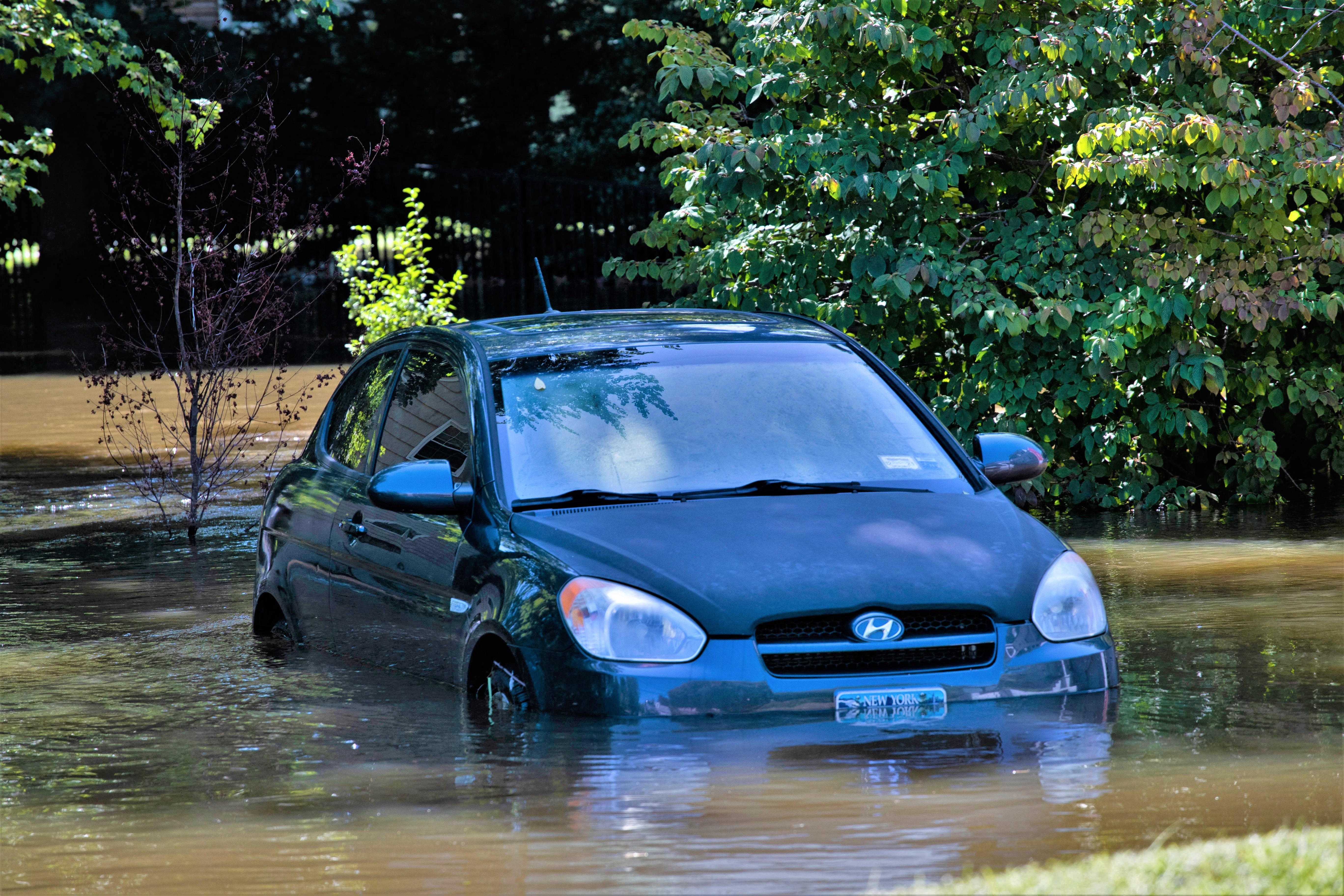
A car remains submerged in floodwater in Mamaroneck the day after Hurricane Ida struck, on September 2, 2021. (Getty)
Less than two weeks after Tropical Storm Henri made landfall, the Northeast was walloped with record rainfall — this time from Hurricane Ida — which caused flash flooding throughout Westchester County, inundated its drainage and infrastructure, and led to five casualties.
As the torrential rain began on Sept. 1, Westchester resident and single mother Chelsea Chapman was on the second floor of her house where one of her four daughters was trying on clothes and doing a fashion show. When the two went downstairs to get something, they heard an alarm going off in the basement.
There, they saw that water was on the floor. Initially, Chapman thought it wasn’t so bad, and if the basement got water damage, it would cost a couple thousand dollars to repair. But the water kept coming.
All of the family’s keepsakes, including family photo albums and trunks that held each of Chapman’s daughters’ childhood mementos, as well as file cabinets with important documents, were kept in the basement. Chapman and her twin daughters, Felicity and Lilibet, started to pass boxes upstairs, one by one, and as the water continued to get higher, Chapman began to panic.
“It went in very slow motion, but I would say within two minutes the basement was completely underwater,” Chapman said. “We ran up the stairs as fast as we could and literally the water was chasing us inch by inch.
“Whoever was last, [the water] was probably on their heels,” Chapman continued. “We shut the basement door, and the door immediately busted open with water and it just started pouring into the house.”
As the water began spilling onto the first floor of the house, the situation continued to escalate. The water steadily rose, beginning to make its way up the stairway onto the second floor and reaching above the light switches. The whole family, including a three-legged Alaskan Malamute that they were dog sitting at the time, went upstairs into one room. “Then I’m in an absolute panic, and I’m thinking, how can we get on the roof?” Chapman said, sharing that, at this point, her daughters were begging to leave the house. “I looked out the window, and I felt like Dorothy in The Wizard of Oz,” Chapman remarked. “We were stuck.”
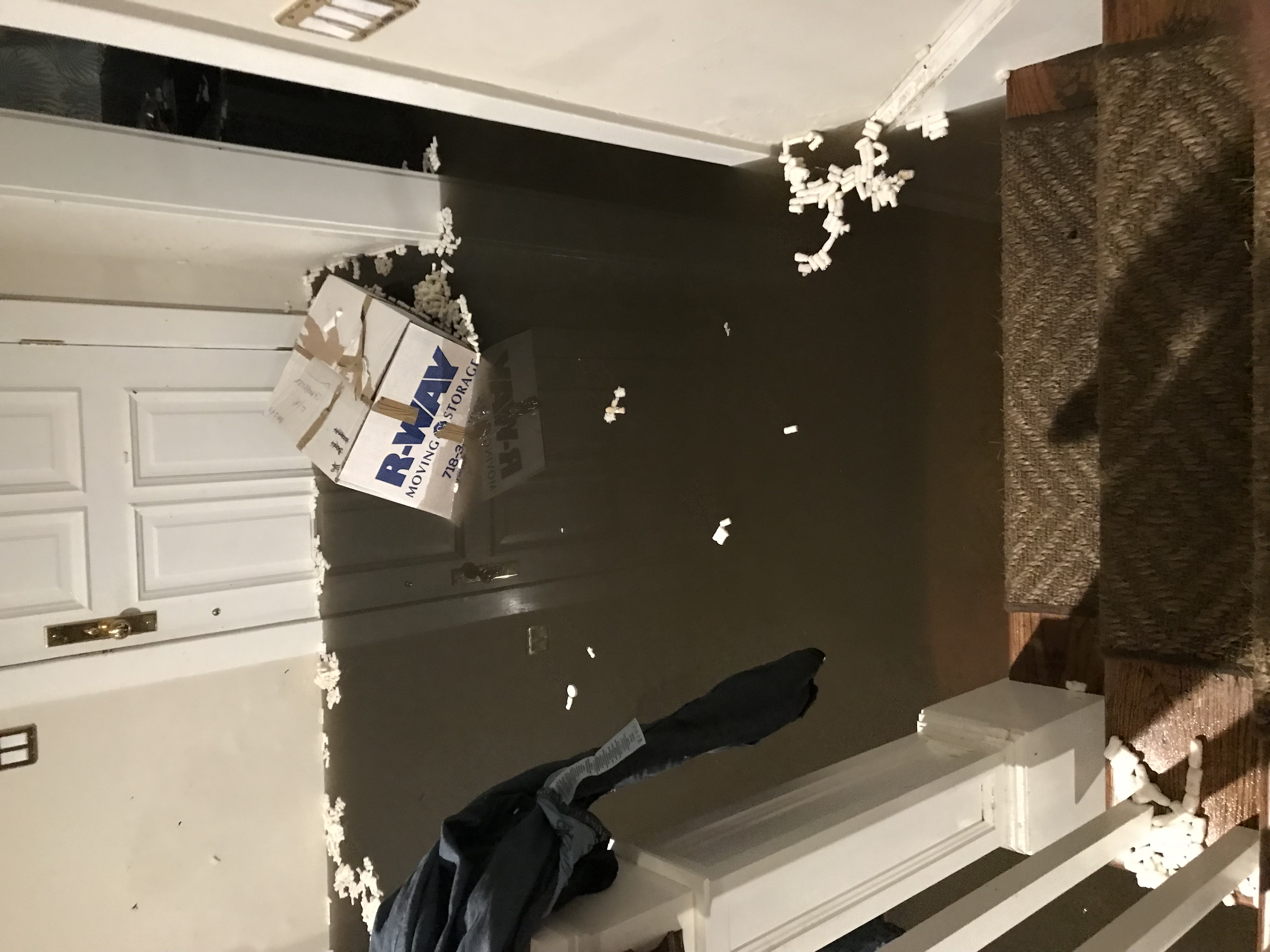
Inside Chelsea Chapman’s home when Hurrican Ida struck. (Courtesy Chelsea Chapman)
Chapman called the dog’s owner, who called the police. Luckily, a rescue team just made another rescue near Chapman’s home and arrived within, what Chapman said, felt like seconds. One member of the rescue team threw his rope into Chapman’s daughter’s bedroom window, they tied the end of his rope to her bed, and he climbed through the window. Chapman’s daughter, Ophelia, has Down’s Syndrome and, Chapman said, has always had so many questions about the weather, asking about each day’s forecast and what warning messages like a flash flood alert meant.
“I would always say, ‘Honey, the weather is never going to hurt you. I know it sounds loud, it may hurt your ears, but it’s never going to come into our house,’” Chapman said. “I said that so many times. I said it that week, I probably said it that day.”
Although Chapman pleaded with the rescue team to take them out another way so Ophelia wouldn’t have to see the water in the house, it was the only way out. “There was such a sense of relief seeing [the rescue team] because some people sit on their roofs or sit in their houses, and the officers never come.”
CODE RED
Following Hurricane Ida, President Biden visited areas of New York and New Jersey to survey the damage.
Less than a month after the United Nations’ Intergovernmental Panel on Climate Change (IPCC) report came out, sounding the alarm that it is a “code red” for human-driven global heating, President Biden said Hurricane Ida’s destruction was a sure sign of a nation, and world, “in peril” from climate change. Without drastic action, he said, extreme weather patterns would only worsen.
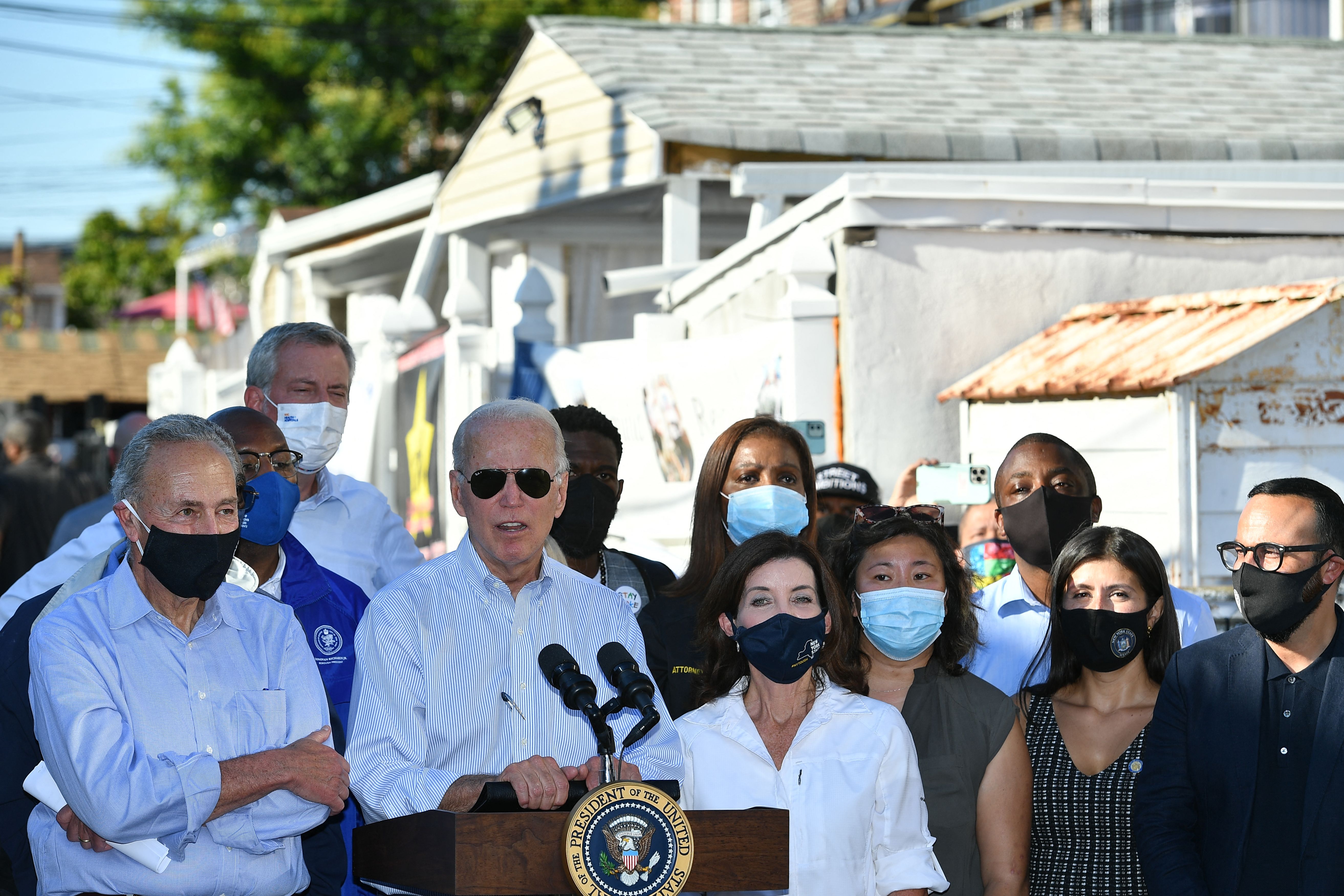
President Biden speaks, flanked by US Senator Chuck Schumer (left) and New York Governor Kathy Hochul (right) after surveying the damage in New York from Hurricane Ida on September 7, 2021. (Getty)
“The flooding caused by the remnants of Ida resulted from a completely different mechanism — very intense rainfall that overwhelmed both the natural drainage capacity provided by our soils, streams, and rivers and the engineered drainage provided by storm sewers,” Bernice Rosenzweig, a Professor of Environmental Science at Sarah Lawrence College whose research focuses on urban hydrology and climate change resilience, said.
“While stream and river flooding is considered in the flood insurance studies used for mapping flood hazards, we, unfortunately, haven’t done a good job in mapping the areas at risk of flooding when storm sewers are overwhelmed,” Rosenzweig said.
This is a particularly important factor to consider, Rosenzweig noted, because climate change will make these types of rain events more intense when they occur, seeing as warmer air can hold more moisture and generate more intense rain during storm conditions.
Intense rainfall events, which are one of the main drivers of flooding in the Westchester area, have become more frequent across the northeastern United States. And, due to climate change, their frequency will only increase in the coming decades.
“Storms like those caused from the remnants of Ida demonstrate how poorly our infrastructure functions during extremely intense rainfall,” Rosenzweig said.
While there is no one solution to upgrade infrastructure for a rapidly changing climate, both green and gray infrastructure can help. This includes infrastructural efforts like rain gardens and storm sewers designed based on a historic record of rainfall.
“As our climate changes, intense rainfall that is considered rare and extreme today will become the ‘new normal,’” Rosenzweig said. “If we don’t act quickly to prevent the worst scenarios of climate change from becoming our reality, we will not be able to afford the costs of the infrastructure upgrades needed to prevent flooding from the more frequently occurring rain events.”
UNDERWATER AND OVERWHELMED
In the Town of Mamaroneck, 8.5 inches of rain caused an estimated $1 million in damages to the town infrastructure and flooded many residents’ homes.
“We used to think that [Tropical Storm] Lee and [Hurricane] Irene were the worst flooding that we’ve ever seen, but this was far worse,” Mamaroneck Town Supervisor Nancy Seligson said, highlighting that wind and trees coming down are often thought of as the biggest enemy during extreme weather events. But Hurricane Ida proved it was water.
“If we don’t act quickly to prevent the worst scenarios of climate change from becoming our reality, we will not be able to afford the costs of the infrastructure upgrades needed to prevent flooding from the more frequently occurring rain events.”
The Town of Mamaroneck has implemented various green infrastructure projects to improve its resiliency, including fortifying the river banks with more natural plantings, adding two rain gardens, putting filters in catch basins to collect oil, grease, and sediment from runoff, and installing rain barrels. And the Town also takes preventive measures prior to an oncoming storm, such as lowering the large reservoir’s water level.
“In this case, we went as low as we’ve ever gone before, and that helps because it captures the first flush of water and delays downstream deluge,” Seligson said. “But [the hurricane] still comes with this amount of water.”
Because the Town is the recipient of a large watershed above it, Seligson underscored that it’s not only a matter of what happens in her own municipality but rather the entire drainage area above.
“I try and use the storms as an opportunity to highlight the climate crisis that we’re having and the need for individuals and everyone to take measures to improve it,” Seligson said.
Eight years ago, Seligson started the Sustainability Collaborative, a volunteer-run committee created to advise the Town on environmental issues and devise and implement programming. Mitch Green, Chair of the Sustainability Collaborative, said the group’s three broad themes this year are minimizing waste, reducing emissions through clean, more reliable energy, and strengthening community health for the Town’s residents, air, land, and water.
“Our objectives are to advance the resilience, sustainability, and quality of life of the town and residents of Mamaroneck,” Green said. In regard to protecting areas from storm surge and flooding, the Collaborative is focused on flood damage prevention, extreme heat and health risk reduction, air quality restoration and emissions reduction, clean emergency power, and insurance affordability protection. Looking at all aspects of the Town’s operations through the lens of climate change, Green underscored, will help Mamaroneck bolster its resilience in the years ahead.
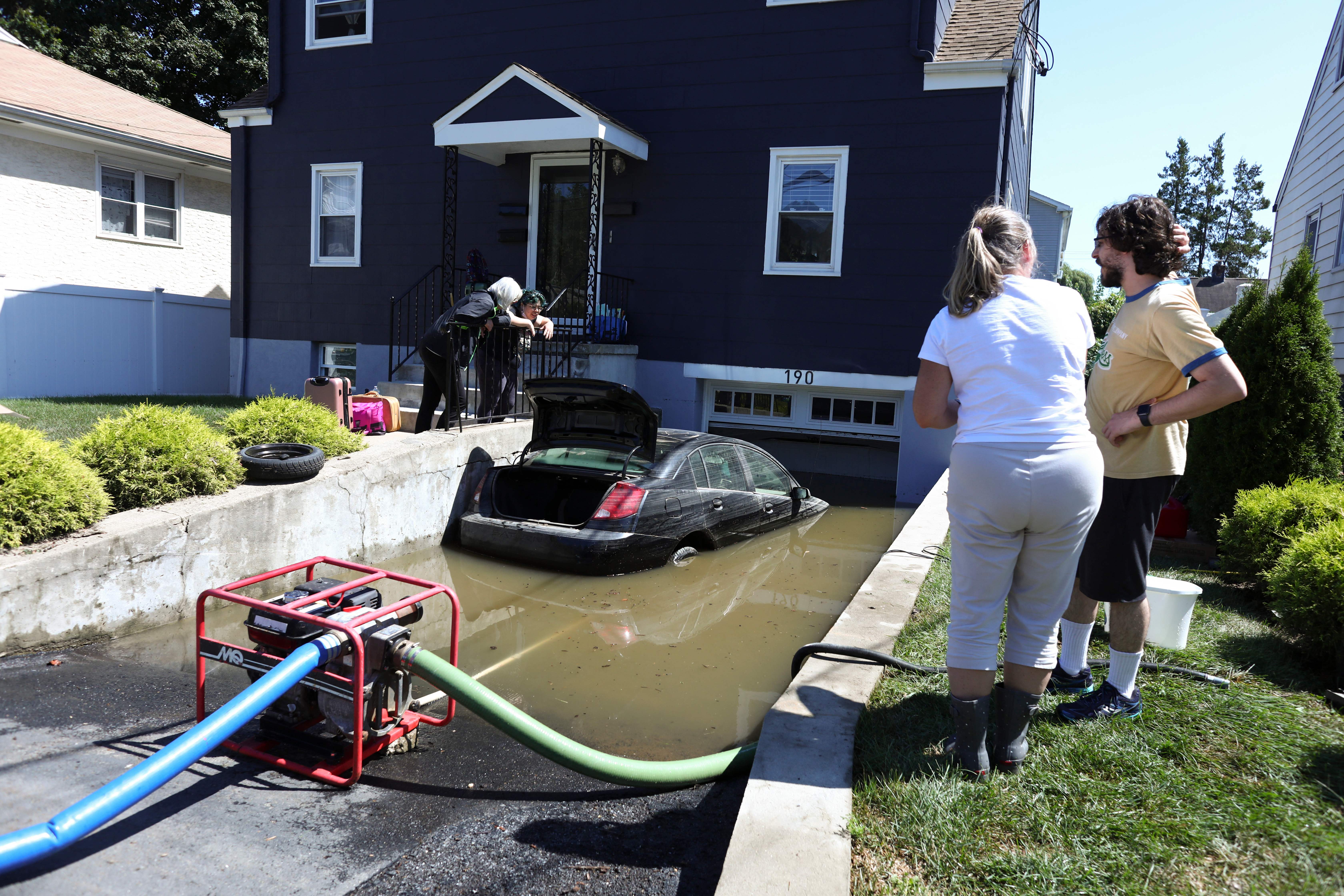
Residents in Mamaroneck recover from Hurricane Ida’s devastation. (Getty)
In the Village of Mamaroneck, which got 14 feet of water in some neighborhoods and $18 million worth in damages from Ida, a vital flood mitigation project will likely move forward. After surveying Mamaroneck’s flood damage, Senate Majority Leader Chuck Schumer said he made a personal call to the Office of Management and Budget (OMB) to urge the agency to greenlight the Mamaroneck and Sheldrake River Flood Risk Management Project, which has been stalled for two years, despite strong support for the project from the U.S. Army Corps of Engineers.
“Since the last raindrop fell, I have been advocating for our community to finally get the Army Corps of Engineers plan funded for Mamaroneck,” Village of Mamaroneck Mayor Tom Murphy said at a press conference following Ida.
The $88 million project plan — developed for streambank erosion control for the Mamaroneck and Sheldrake Rivers — includes channel modifications, retaining walls, and bridge replacements with the goal of reducing flood risk to property and residents in these areas.
Design work, according to an Army Corps spokesperson, could begin in 2021 or early 2022, assuming OMB greenlights the project.
KEEPING THE LIGHTS ON AND TANKS FULL
To help strengthen the County’s resilience to not only floodwaters but also disruptions to power, some parts of the electrical grid are going underground.
In Yorktown, Con Edison is beginning to bury 2,200 feet of overhead electric wires on Foothill Street and Lockwood Road — part of a regional storm resilience pilot program and the utility company’s first effort in Westchester County.
“If the pilot program works according to its design, the burial of the power lines will reduce the frequency and length of power outages in that neighborhood,” Yorktown Town Supervisor Matthew Slater said in a statement to Examiner+.
“Punishing storms are hitting us once a year or more often, so our utility companies must undertake multiple efforts to enhance our grid’s resilience,” Slater continued. “The burial of at-risk power lines is a good first step, but it cannot end there.”
To further mitigate power-related disruptions due to extreme weather events, the New York State Energy Research and Development Authority (NYSERDA) implemented the Fuel NY Initiative, which installed transfer switches that could connect to a generator and permanent generators at participating gas stations throughout the state.
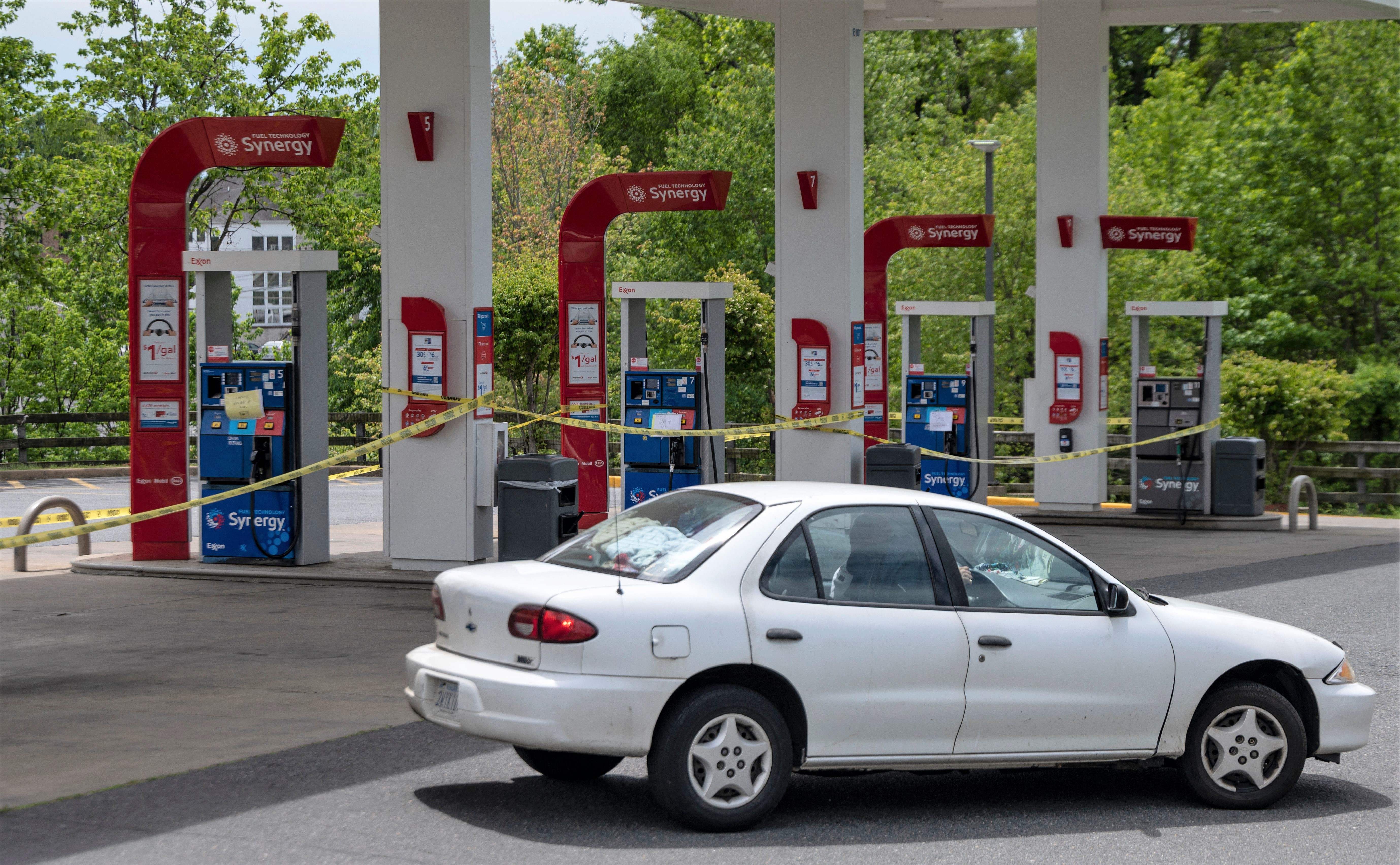
(Getty)
In Westchester, 23 permanent generators and 96 transfer switches were installed by NYSERDA, which will provide gas stations scattered throughout the County with critical backup power in the event of widespread power outages due to storms.
LIVING ON THE EDGE
Despite increasingly extreme weather events, living near the water is still a risk many are willing to take. The demand for, as well as the value of, waterfront properties remains high, Gino Bello, a White Plains-based real estate broker, said.
Last spring, the Federal Emergency Management Agency (FEMA) released new flood insurance rating procedures, which are meant to equitably distribute the cost of insurance for potential flood damage based on the risk a property faces. The new methodology, which went into effect this month, will result in immediate cost reductions for 23 percent of existing policies. However, more than 3.8 million will see their rates increase. In New York, an estimated 171,100 policies will be impacted, with 68 percent seeing an increase.
Rick McClatchie, President at Morrell Insurance in White Plains, said when re-quoting some existing flood insurance policies for his clients recently, he has seen prices go up. In the weeks following Hurricane Ida, McClatchie has had more people reach out to get flood insurance policies — even if they are in a moderate-to-low-risk area.
“I find that a lot of people only get the coverage if they’re forced to,” McClatchie said, highlighting that if you’re in a higher risk flood zone and applying for a mortgage, a bank will require you to carry flood insurance. Without that, it’s not a requirement for homeowners. “It’s kind of out of sight, out of mind,” McClatchie said. “No one’s really going around looking for an extra expense.”
But with Hurricane Ida, many saw that flash floods made their homes vulnerable, regardless of if they’re by water or not. “It wasn’t too hard for us to see the writing on the wall that [flood insurance] was going to start to be a necessity,” McClatchie said.
Bello believes builders and contractors working on coastal properties will have to start taking more frequent storms into account and make adjustments to homes, such as raising them as many coastal property owners did after Superstorm Sandy. “Everyone always wants to have a waterfront property with great views,” Bello said. “[But] there are still some risks, and those risks are becoming very apparent now in 2021.”
PULLING TOGETHER
After the flood, Chapman was astonished by the outpouring of support from her community — even from people who didn’t know her family personally.
Hundreds of people banded together, helping Chapman clean out the house. They donated their time and money, often stepping up to help salvage household items Chapman thought would have to be thrown out.
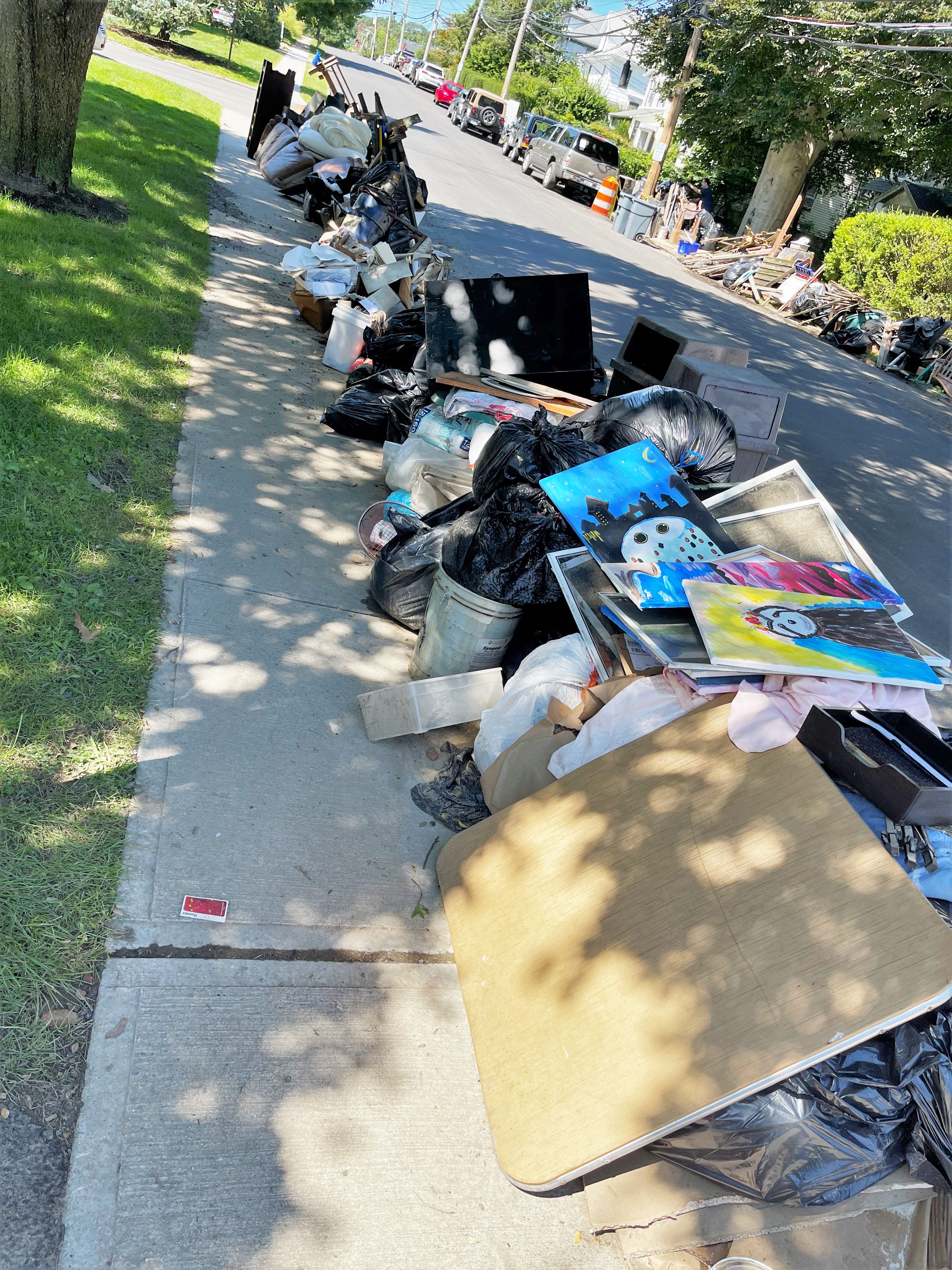
Chapman tries to dry out some of the items she salvaged from her flooded home. (Courtesy Chelsea Chapman)
Someone took every item from Chapman’s kitchen to clean at their house. Another took the family’s bicycles, including Ophelia’s brand new special needs bicycle. Someone else took every single photograph and piece of paper to dry out at their house. And another took every single pair of muddy, waterlogged shoes to clean.
“That just continued to happen, [people asking] ‘what do you need?’ and I would say, ‘I need this,’” Chapman said. “And it would show up on my doorstep within twenty minutes.”
A friend that Chapman knows through her daughter’s school set up a GoFundMe page for the family, which Chapman said will be their saving grace. “Had that friend not done that, we would be in a financial crisis,” Chapman said. “I will never in my lifetime be able to thank that person enough.”
Chapman was fortunate enough to have flood insurance that covered the property itself, but it did not cover the contents of their house. She filed a FEMA flood claim and is still waiting to hear back — hopeful that it will help pay for a portion of the damage.
Now, the rebuilding phase has begun.
“It’s our family home,” Chapman said. “You don’t walk away from it.”
Bailey Hosfelt is a full-time Reporter at Examiner Media, covering LGBTQ+ issues, climate change, the environment, and more. You can follow Bailey on Twitter at @baileyhosfelt.

Examiner Media – Keeping you informed with professionally-reported local news, features, and sports coverage.


